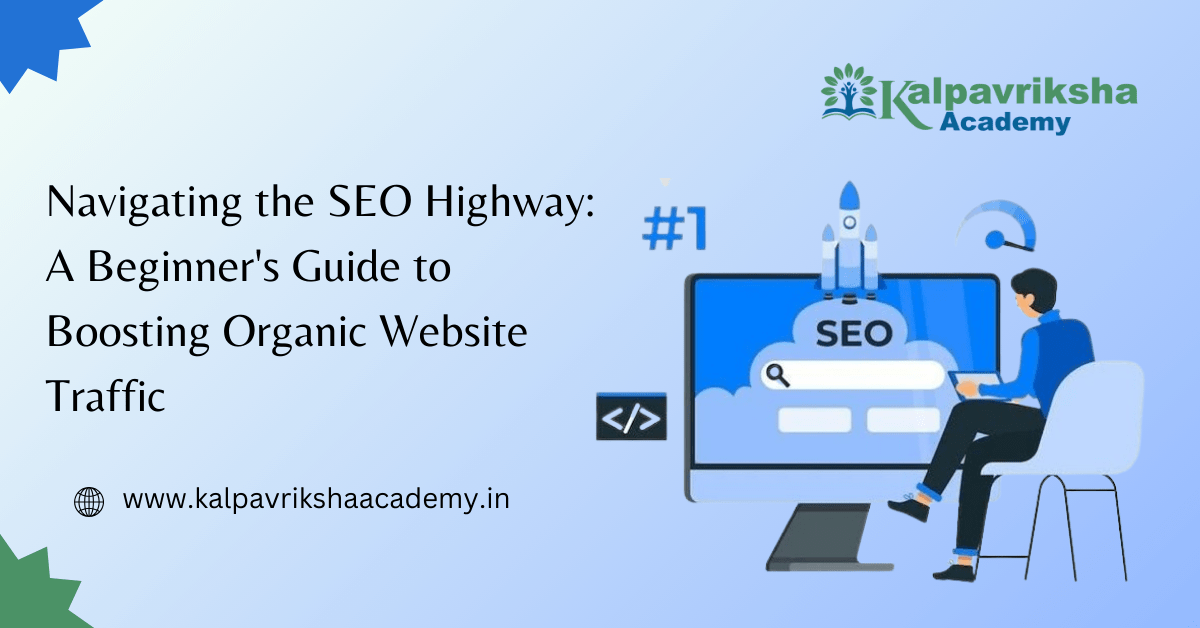A Beginner’s Guide to Boosting Organic Website Traffic
In the vast digital landscape, where websites compete for attention, organic traffic acts as the lifeblood of online success. Understanding how to increase organic website traffic through effective Search Engine Optimization (SEO) strategies is crucial for any website owner or marketer. In this guide, we’ll take a journey through the basics of organic website traffic, its importance, methods to track it, and ten actionable ways to boost it, all while highlighting the benefits of investing in an SEO course online.
Let us first understand what organic website traffic is. This is before we dive into SEO tactics. In simple terms, organic traffic is the term for users who find your website through natural, unpaid search engine results. Organic traffic is influenced by the relevancy and quality of your website’s content as well as its visibility on search engine results pages (SERPs), as opposed to paid traffic, which is generated by advertisements.
Importance of Organic Website Traffic
Organic website traffic holds significant importance for several reasons. Firstly, it indicates that your website is being discovered by users who are actively searching for information, products, or services related to your niche. Secondly, organic traffic tends to be more sustainable and cost-effective in the long run compared to paid traffic. Additionally, high-quality organic traffic often leads to higher conversion rates and better user engagement, contributing to the overall success of your website.
How to Track Website Traffic ?
Tracking website traffic is crucial for understanding your audience, evaluating the effectiveness of your marketing efforts, and identifying areas for improvement. Fortunately, there are several tools and methods available to track website traffic effectively. Below these are some key steps to track website traffic:
- Use Web Analytics Tools: Web analytics tools provide valuable insights into your website’s traffic, visitor behavior, and performance. The most popular and widely used tool for website traffic tracking is Google Analytics. It offers a wide range of features, including traffic sources, audience demographics, behavior flow, conversion tracking, and more. To get started, sign up for a Google Analytics account, install the tracking code on your website, and start collecting data.
- Set Up Goals and Conversions: Define specific goals and conversions that you want to track on your website, such as form submissions, newsletter sign-ups, product purchases, or page views. By setting up goals in Google Analytics, you can track and measure the effectiveness of your marketing campaigns and website optimization efforts in achieving these objectives.
- Monitor Traffic Sources: Analyze the sources of your website traffic to understand where your visitors are coming from. Google Analytics provides insights into various traffic sources, including organic search, direct traffic, referral traffic, social media, paid search, and email marketing. By identifying the most significant traffic sources, you can allocate your marketing resources more effectively and focus on channels that drive the most valuable traffic.
- Track Key Metrics: Monitor key metrics such as total website traffic, unique visitors, page views, average session duration, bounce rate, and conversion rates. These metrics provide valuable insights into the overall performance of your website and help you identify trends, patterns, and areas for improvement. Set up custom dashboards and reports in Google Analytics to track these metrics regularly and gain actionable insights into your website’s performance.
- Segment Your Audience: Segment your website traffic based on various criteria such as demographics, geography, device type, traffic source, and user behavior. By segmenting your audience, you can gain deeper insights into different user groups, understand their preferences and needs, and tailor your marketing strategies accordingly. Use Google Analytics segments or advanced filters to create custom segments and analyze specific subsets of your audience.
- Monitor User Behavior: Analyze user behavior on your website to understand how visitors interact with your content, pages, and conversion paths. Use features like behavior flow, site content, and events tracking in Google Analytics to visualize user journeys, identify popular pages, and pinpoint areas where visitors are dropping off. By optimizing your website based on user behavior data, you can improve the overall user experience and drive more conversions.
- Track External Campaigns: If you’re running external marketing campaigns such as email marketing, social media ads, or PPC campaigns, use tracking parameters like UTM parameters to track the effectiveness of these campaigns in driving website traffic and conversions. By adding unique tracking parameters to your campaign URLs, you can monitor campaign performance in Google Analytics and attribute traffic and conversions accurately to each campaign.
- Monitor Site Speed and Performance: Keep an eye on your website’s speed and performance metrics to ensure fast loading times and a smooth user experience. Use tools like Google PageSpeed Insights or GTmetrix to analyze your website’s speed, identify performance issues, and implement optimizations to improve loading times. Faster websites tend to have lower bounce rates and higher engagement rates, leading to better overall website performance.
- Regularly Review Reports and Insights: Schedule regular reviews of your website traffic reports, performance metrics, and audience insights in Google Analytics. Look for trends, anomalies, and opportunities for optimization, and use these insights to refine your marketing strategies, content creation efforts, and website optimization tactics. By staying informed and proactive, you can continuously improve your website’s performance and drive sustainable growth over time.
10 Ways to Increase Website Traffic
Now, let’s explore ten actionable strategies to increase organic website traffic:
- Keyword Research and Optimization: Conduct thorough keyword research to identify relevant terms and phrases that your target audience is searching for. Integrate these keywords strategically into your website’s content, including titles, headings, meta descriptions, and body copy, to improve its visibility on SERPs.
- Create High-Quality Content: Craft compelling and valuable content that addresses the needs and interests of your target audience. Focus on producing informative blog posts, articles, videos, infographics, and other types of content that provide solutions to their problems and establish your authority in your niche.
- Optimize On-Page Elements: Pay attention to on-page optimization factors such as title tags, meta descriptions, headings, and image alt text. Ensure that these elements accurately reflect the content of your pages and include relevant keywords to improve their relevance and click-through rates on search engine results.
- Improve Website Loading Speed: Optimize your website’s loading speed to provide a better user experience and reduce bounce rates. Compress images, minify CSS and JavaScript files, enable browser caching, and utilize content delivery networks (CDNs) to accelerate page loading times.
- Mobile-Friendly Design: With the increasing use of mobile devices, it’s crucial to ensure that your website is optimized for mobile users. Use responsive design principles to create a seamless browsing experience across all devices and screen sizes, improving your website’s accessibility and search engine rankings.
- Build High-Quality Backlinks: Earn high-quality backlinks from reputable websites in your industry to boost your website’s authority and credibility in the eyes of search engines. Focus on creating valuable content that naturally attracts backlinks from relevant sources, and avoid spammy or black-hat link-building tactics.
- Utilize Social Media: Leverage social media platforms to promote your content and engage with your audience. Share your blog posts, articles, videos, and other content across popular social networks like Facebook, Twitter, LinkedIn, Instagram, and Pinterest to increase visibility and drive traffic back to your website.
- Optimize for Local SEO: If your business has a physical location or serves a specific geographic area, optimize your website for local search engine optimization. Claim your Google My Business listing, optimize your website for local keywords, and encourage customer reviews to improve your visibility in local search results.
- Regularly Update and Refresh Content: Keep your website’s content fresh and up-to-date by regularly publishing new articles, updating existing pages, and refreshing outdated content. This not only provides value to your audience but also signals to search engines that your website is active and relevant.
- Monitor and Analyze Performance: Continuously monitor and analyze your website’s performance using web analytics tools. Track key metrics such as traffic, engagement, conversion rates, and keyword rankings to evaluate the effectiveness of your SEO strategies and make data-driven decisions to optimize your website further.
Conclusion
Increasing organic website traffic with SEO is a multifaceted process that requires dedication, patience, and ongoing effort. By implementing the ten strategies outlined above and investing in your education with an SEO course online, you can enhance your website’s visibility, attract more visitors, and achieve your business goals in the digital age.
While these strategies can help you increase organic website traffic, mastering the intricacies of SEO requires continuous learning and adaptation. Enrolling in an SEO course online in Kalpavriksha Academy can provide you with in-depth knowledge, practical skills, and the latest industry insights to stay ahead of the curve. Whether you’re a beginner looking to learn the fundamentals or a seasoned professional seeking advanced techniques, a comprehensive SEO course can equip you with the resources and strategies needed to succeed in the competitive online landscape.










